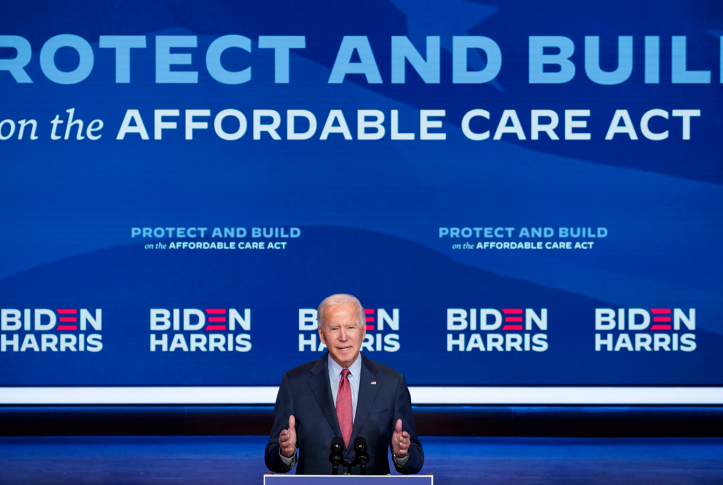Having consistently placed a federal public option at the core of his campaign’s health care platform, President-elect Biden will seek to deliver on this promise after he takes office. The term “public option” holds different meanings for different audiences, but usually refers to a new form of health insurance coverage that presents an alternative to existing commercial plans and includes a stronger government role in oversight and administration. The goal is to expand access to quality, affordable coverage.
Even considering the outcome in the Georgia run-off elections and the makeup of the 117th Congress, federal public option legislation is likely to face an uphill battle in Congress. To advance the goal of offering a public option alongside commercial plans, Biden could turn to existing federal waiver authority that permits flexibility to implement alternative coverage and ensure funding for state initiatives.
Biden’s Federal Public Option Proposal and Prospects for Congressional Action
As a candidate, President-elect Biden proposed establishing a new federal public option program to be administered by Medicare. This suggests it will be “Medicare-like” — relying on officials at the Centers for Medicare and Medicaid Services (CMS) to oversee implementation and operation of the program. This includes, according to the Biden plan, “negotiating” reimbursement rates with health care providers and drug and device manufacturers “in the same way that Medicare does.”
However, that is not what Medicare does. CMS administers prices and participating providers must accept them; there is no negotiation. This is an important point to consider because the prices that a public option program pays for products and services will be the primary driver of premiums and potential savings to consumers.
Under the Biden proposal, the plan would be made available to everyone, including people with access to employer-based coverage. This is an expansive application of the policy, which amplifies its impact for ensuring coverage gains as well as potential for controversy and opposition.
Congressional action is needed to fully realize this plan. While public opinion polls continue to demonstrate high-level support for a public option, many Democrats in Congress — especially those from moderate states and districts — remain wary and political support becomes tenuous as proposals become more specific. This is due in no small part to the revenue implications for the health care industry and the potential loss of health care sector jobs that could accompany them.
Potential Use of Executive Authority
In the face of a daunting legislative pathway, President-elect Biden has an alternative for advancing his agenda. Existing waiver authority under Section 1332 of the Affordable Care Act gives states flexibility to adopt coverage programs that deviate from the law’s framework if doing so provides equivalent coverage at the same or lower cost.
Under a 1332 waiver, states have access to additional federal funding that could be critical in advancing coverage reforms. Section 1332 can be used to extend eligibility for premium tax credit (PTC) subsidies to public option enrollees even if they would not otherwise qualify — for example, if income is above 400 percent of the federal poverty level or the option is offered outside the state’s marketplace. Section 1332 also could allow the state to recapture savings that would otherwise accrue to the federal government. This is known as “pass-through funding” —for example, the federal cost savings that accrue from subsidies because of lower public option premiums would be refunded to states. States can use pass-through funding to defray program costs, enhance benefits, and expand consumer subsidies, among other options.
The Obama and Trump administrations both used Section 1332 waivers to allow states to implement reinsurance programs, which share spending on higher-cost enrollees with insurers as a way to reduce premiums marketwide. While the states did not require a waiver to implement these programs, doing so allowed them to capture pass-through funding. The premium reductions that reinsurance produces lowers what the federal government must spend on PTC subsidies in those markets.
Similarly, while states do not necessarily require a federal waiver to implement a public option program (e.g., Washington), many may choose to pursue one to access federal pass-through funding. Without it, any new spending on subsidies or other benefit enhancements would be the state’s responsibility. If the state’s public option initiative is aggressive enough to drive meaningful cost reductions, however, states could stand to receive substantial funds to defray these costs.
In establishing a 1332 waiver program, the administration would likely seek to accommodate a range of state-driven models. For example, Colorado has proposed a public option initiative that would require hospitals and health plans to participate and set hospital reimbursement rates on a site-by-site basis, usually at a steep discount to existing commercial rates. Legislators in Connecticut, on the other hand, recently proposed opening the state’s employee health benefit program to individuals and small businesses, while also potentially creating a new state-run coverage option in its ACA marketplace.
Conclusion
With gridlock over the issue likely in the new Congress, the goal of advancing public option programs will likely rest with the states. The federal government will need to leverage the tools at its disposal to support states in achieving their cost reduction and coverage expansion goals. With Section 1332 waiver authority as its primary resource, the Biden administration can afford states the flexibility and funding they may need to succeed in implementing these novel programs.

